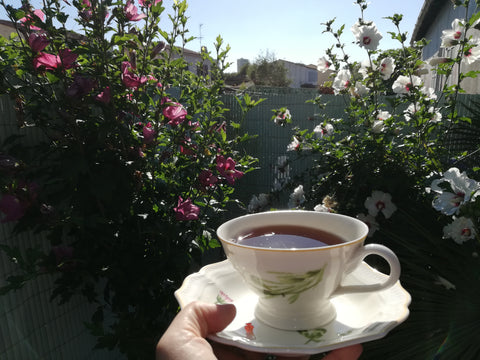How to make oolong tea

Oolong tea is neither green nor black. While green tea is not oxidized and black tea is fully oxidized, oolong is partially oxidized and can be placed somewhere in between the two. Its leaves are twisted or rolled and its taste is very mild, almost sweet. Many health benefits are attributed to oolong tea including its capacity to accelerate weight loss.
Oolong tea has been known in China for three centuries and is best appreciated when using the traditional Chinese tea drinking techniques.
How to make oolong tea using a gaiwan
Gaiwan was invented during the Ming dynasty. It is a lidded bowl without a handle, placed on a saucer. The small bowl symbolises earth, the tea cup mankind and the lid heaven. That's why it is also known as "a bowl of the three talents." It is usually made from porcelain and often sports exquisite decorations.

To prepare oolong tea using a gaiwan:
- heat the gaiwan using hot water to prepare it for infusion and symbolically purify it
- place one heaping teaspoon of oolong tea leaves in the bowl
- poor boiling water over the leaves and stir with the lid
- leave the leaves to infuse for one minutes or less
- when the infusion is ready, transfer it to a separate bowl, holding the leaves with the lid. Use the saucer to get a firmer grip of the gaiwan
- don't leave any liquid in the bowl of the gaiwan, only the leaves
- inhale the aromas emanating from the leaves and from the lid
- taste
- repeat one or twice. Each subsequent infusion should last longer.
How to make oolong tea using the gongfu cha technique
The name gongfu cha (工夫茶) can be translated as "the time for tea" and uses the same term as the one related to martial arts (kung fu). This way of drinking tea has been popular in China since the 17th century. Its goal is to be able to infuse the same leaves multiple times and discover new tastes with each tasting.
The gongfu cha technique can require as many as eleven utensils. In its simplest form, the following tools are needed:
- a small teapot
- a bowl into which the teapot can be placed (cha chuan)
- a container with a spout (cha hai)
- an elongated cup for sniffing the tea (wen xiang bei or cha bei)
- a kettle
- a wooden tray with holes on which you can place all the elements

To prepare oolong tea following the gongfu cha technique:
- rinse the teapot with hot water - pour some simmering water into it and empty it into the cha hai
- once the teapot is rinsed add 2 or 3 teaspoons of tea
- rinse the leaves - pour some simmering water over them and discard this water into the cha hai. Hold the leaves with the teapot lid so that they don't fall out
- fill the teapot with simmering water until it overflows. Place the lid back on the teapot and pour water over the outside of the teapot. The goal of using the wooden tray with holes as the basis for the preparation is to have the liquid fall into the holes of the tray.
- empty the cha hai to prepare it to receive more liquid
- wait for up to one minute for the first infusion
- empty the liquid into the cha hai. Make sure no liquid is left inside.
- fill the sniffing cup (wen xiang bei) and then transfer the liquid into the tasting cup
- now it's time to inhale the fragrances emanating from the now empty wen xiang bei, especially on the sides of the cup
- taste
- repeat once or twice. Each subsequent infusion should last longer.
How to make iced oolong tea
If these complex techniques sound intimidating, you could try serving oolong as a cold brew. Simply pour ambient temperature water over your tea leaves and leave to steep for at least thirty minutes. Refreshing and delicious!
Cha xi principle - surround your tea with beauty
Whatever the technique you use, keep in mind the cha xi principle, a practice that consists of surrounding the preparation of tea with beauty. The notion of cha xi dictates that both the tea and the ustensils are selected carefully and placed in a harmonious way.
As Yuan Hongdao, a Ming dinasty literary figure teaches us: "Tea drinking is the highest form of the art of life."

Laissez un commentaire